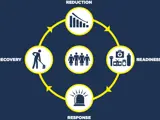The Bay of Plenty Civil Defence Emergency Management Group (Bay of Plenty CDEM Group) is established under The Civil Defence Emergency Management Act 2002 (The CDEM Act 2002).
The CDEM Act 2002 requires every regional council and every territorial authority within that region to unite to establish a Civil Defence Emergency Management Group (CDEM Group).
Who are the Bay of Plenty Civil Defence Emergency Management Group?
Members of the Bay of Plenty CDEM Group include:
- Bay of Plenty Regional Council
- Kawerau District Council
- Ōpōtiki District Council
- Rotorua Lakes Council (legally Rotorua District Council)
- Tauranga City Council
- Western Bay of Plenty District Council
- Whakatāne District Council
Visit the Bay of Plenty Civil Defence Emergency Management website.
Why do we have Civil Defence Emergency Management?
The role of Civil Defence is to take an integrated approach to emergency management, based on Reduction, Readiness, Response and Recovery.
Bay of Plenty CDEM Group supports communities to:
- Identify and understand their risks, and take steps to eliminate or reduce those risks.
- Develop capabilities and operational systems before an emergency happens so communities are prepared – this includes developing personal, family/whanau, business and community preparedness.
- Take action immediately before, during and directly after an event to save lives and protect property.
- Put in place coordinated efforts and processes to assist with immediate, medium-term and long-term recovery following an emergency.
CDEM arrangements ensure coordination and communication happens, and that support is available when it’s needed. Ultimately, the work of CDEM enables communities to be more resilient to the impacts of emergencies.



